
by Judy Corbus | Aug 27, 2021
Next to ensuring your family’s safety and well-being during a hurricane, having a game plan to protect your largest investment – your home and property – is essential in preparing for a major storm or other disaster. Many of these tasks can be done as part of routine home maintenance well before a storm is on the horizon.
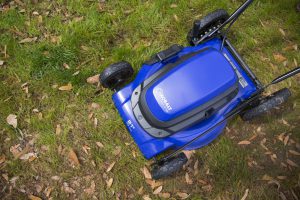
Mow your yard before a storm to make clean-up easier. Photo credit: UF/IFAS Photo by Camila Guillen
Let’s start with the outside:
- Trim back limbs and branches hanging over the roof and any dead limbs elsewhere in the yard. These can break off in high winds, causing roof and siding damage.
- Clean valleys, gutters, and downspouts of leaves and debris. This will improve water flow off the roof, reducing the risk of leaks.
- If a storm is approaching, move trash cans, lawn furniture, grills, decorative items, potted plants, and toys to the garage, shed, or other secure storage area. These items can become flying missiles in high winds!
- Protect windows with plywood or roll-down shutters. These protective barriers can:
- keep wind pressure from building up inside, leading to roof loss
- reduce the chance of glass breakage
- reduce the risk of wind-driven rain damaging your home’s interior
- Be sure to install plywood before wind speeds increase!
- Do NOT apply tape to windows. Tape will not protect against breakage from flying debris and wastes time and resources. Plus, the adhesive can be very difficult to remove from the glass.
- Protect the garage door with vertical bracing. You can install wooden columns or purchase a kit. For more information, check out Protecting and Securing Garage Doors.
- Check doors, windows, and walls for openings where water can enter. Use silicone caulk to seal any gaps, cracks, or holes – pay special attention to cable and pipe openings into the house.
- Test and service your back-up generator to make sure it’s working properly and check your fuel supply. To prevent carbon monoxide poisoning, use your generator only outside and at least 20 feet away from doors, windows, and vents.
- Mow the yard. This makes post-storm clean-up much easier.
Now, we’ll move inside:
- Check your flashlights and stock up on batteries as needed. Plan on a flashlight for every person in the house plus additional lighting for bedrooms, bathrooms, and common areas.
- Check your weather radio to ensure it’s working properly.
- Check smoke detector and carbon monoxide alarm batteries and replace as needed. Hard-wired alarm systems will operate on the battery backup during a power outage.
- Keep your cell phone and other devices charged when a storm is forecast. Purchase backup charging devices for your electronics.
- Gather disinfectant supplies, trash bags, toilet paper, paper towels, paper plates, cups, and plastic utensils. Put these items in a waterproof/water resistant container to keep them clean and (hopefully) dry in case of flooding.
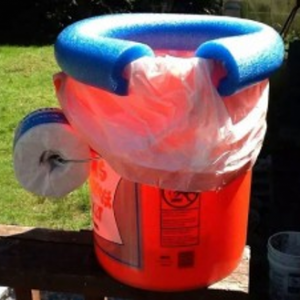
A 5-gallon bucket with a liner can serve as a toilet. Photo credit: Annette Lanham
- If you might be unable to flush the toilet during/after the storm, place a heavy-duty contractor trash bag in the toilet bowl to hold waste. Tie with a plastic tie and dispose of when full or as needed. Another option is to place the bag in a five-gallon plastic bucket. For added comfort, slit a foam pool noodle on one side and slip over the bucket edge for a “seat”; cut to fit. You can have two buckets – one for liquid waste and the other for solids.
- Before the storm arrives, wash dishes, catch up on laundry, clean the kitchen and bathrooms, and empty wastebaskets. This reduces clutter and promotes a clean environment in which to ride out the storm. It also reduces extra work and stress after the storm when water and electricity may be limited or unavailable.
For additional preparation tips, visit Homeowner’s Handbook to Prepare for Natural Disasters
Sources:
Ready.gov
DisasterSafety.org

by Angela Hinkle | Sep 15, 2020
Most of us know there is a great deal of cleanup after a disaster hits. But how often do you think about what to clean before disaster strikes?
Here are some helpful cleaning measures you can do before a storm or other calamity so your burden is not so great after.
Outside
Mow the Lawn
If your lawn is mowed low and even now, you won’t have tall grass to trudge through later. Refill any gas cans and/or re-charge any lawnmower batteries after mowing. It will be much easier to pick up and remove any debris that lands on the mown lawn. And you may need to use the gas in the filled can to operate other equipment for the after-cleanup.
Trim, Whack, and Blow
Trim the hedges, whack down those weeds, and blow those leaves now. Otherwise, you may later find yourself with a big mess on top of a big mess.
Bring It In
Bring in any garbage cans, lawn furniture, or other yard items that could make a mess if blown over, broken, or made into dangerous shrapnel.
Inside
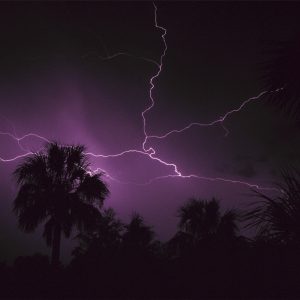
Lightning storm. Photo Source: UF/IFAS
Leave No Piles
Make sure there are no dirty dishes in the sink or the dishwasher. Make sure everything is cleaned, dried, and put away. Then, if you lose electricity after the storm or are not sure of the safety of your water, you don’t have to worry about clean plates to eat on, glasses to drink from, or utensils to eat with. And you don’t have a mess to look at or a stink from the sink to deal with.
Clean, dry, and put away all the dirty laundry now. If you lose that all-important electricity later, you won’t have to worry about stepping over piles of clothes or wonder how you’re going to deal with wearing the same dirty clothes over and over again. If you have a generator, you could use that to clean your clothes, but most of the time those generators are best used to keep food safe in the refrigerator or to operate emergency equipment.
Scrub
If your bathroom tub is scrubbed clean now, you can fill it with water for flushing toilets, cleaning, or purifying and using as extra drinking water. You can also take a relaxing, cleansing bath from a hard, dirty day’s work after the storm.
And cleaning a dirty toilet now means you’ll have one less thing to have to deal with later – along with everything else on your to-do list.
Get Rid of It
Make sure the garbage can, recycle bin, and compost container are all emptied. The last thing anyone needs is old piles of trash with new piles of trash added on top.
Been meaning to give away those extra items (knick knacks, doodads, toys, etc.) you don’t use or like anymore? Doing that now makes for a cleaner house as opposed to having more “stuff” in the house, adding to the mess you may have to deal with later.
Clear the Clutter
Pick up papers, bills, tools, and any other important items that may be on various surfaces throughout the house (you may actually want to eat on that dining room table some day). Then organize them together in a safe place. This helps to keep them from getting water damaged or tossed around and you’ll be able to find them later.
Have your emergency kit filled and ready to go in a plastic tub or waterproof container. Make sure everyone in the house knows where it is. For other disaster preparation and recovery resources, go to https://disaster.ifas.ufl.edu/ and/or talk with your county UF/IFAS Extension Agent.
If your home or property are destroyed in a disaster, these measures probably won’t really help much. But if all is not lost and there is just some debris and damage cleanup to be done after a large weather event, the above measures taken before can alleviate a lot of extra stress after. And if there is no disaster, hey, your house is nice and clean. Relax and enjoy it!
Make sure you clean before disaster strikes.

by Samantha Kennedy | Jun 11, 2020
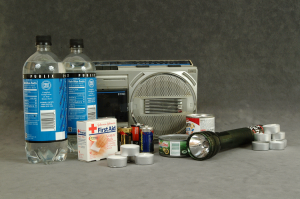
Food and water are, with good reason, most people’s priorities when it comes to stocking their hurricane kit. However, other items are important, too, such as first aid items, sanitation supplies, and extra batteries. (Photo source: UF/IFAS File Photo)
It’s officially hurricane season here in Florida and that means it’s time to review and rebuild your disaster kit. Take some time to go through your kit and make sure you have everything you need. Use this checklist as a starting point and add whatever else you may need.
Replace expired food products and replenish your water supply. Need help deciding what kinds of food and how much water to buy? Let this shopping list be your guide! Remember, focus on nutrition. Balanced, nutritious foods will help provide much-needed, long-lasting energy during stressful times. Family and Consumer Sciences agents in Broward County, FL provide a few tips and tricks for making healthy choices.
Need advice about preparing and storing an emergency water supply? This fact sheet can help!
Keep fresh batteries on hand in all the sizes you will need to power your devices, such as flashlights, radios, and other electronics.
Protect important documents. Many items, such as wills, birth certificates, deeds and liens, and insurance papers may be hard to replace if lost or damaged in a storm. Keep hard copies safe in a waterproof, fireproof lock box. Save digital backups in multiple, secure, and portable places that can be accessed after a storm. This fact sheet provides additional tips for protecting your documents and valuables during a disaster.
Create a digital hurricane kit! Alicia Betancourt, Community Resource Development agent in Monroe County, FL, has put together a comprehensive list of online resources that can help you track the storm, stay in touch with loved ones, and plan your evacuation.
Additional Resources
Disaster Handbook (UF/IFAS)
How to Prepare for Emergencies (American Red Cross)
Ready.gov (U.S. Department of Homeland Security)
UF/IFAS is an Equal Opportunity Institution.

by Angela Hinkle | Sep 3, 2019
Hurricane season is June 1 to November 30, with peak season in September and October. And hurricanes are not the only disasters we have to contend with. Living Well in the Panhandle provides the trusted Disaster Resources you need so you know what to do to keep your family and you living well.
Disaster Resources
Below are helpful resources for preparing for and handling the aftermath of a disaster. For more information, please contact your local UF/IFAS Extension Office.
Food Safety
Is My Food Safe to Eat?
Keeping Your Food Safe During Emergencies: Power Outages, Floods, and Fires
USDA – A Consumer’s Guide to Food Safety-Severe Storms and Hurricanes Guide
Well Water Safety
Well Water Testing
Housing
Search for an open emergency shelter near you by texting SHELTER and your zip code to 4FEMA (43362) Example: SHELTER 01234

Lightning storm. Photo Source: UF/IFAS
Cleaning Up After a Hurricane
Safety Comes First!
Get the Right Tree Care Professional
Hiring an Arborist – Spanish
Cleaning Mold After a Flood
Hurricanes and Mosquitoes
Mosquito Control Tips for Homeowners
Money Management/Consumer Issues
Avoiding Fraud and Deception
Six Steps in Making an Insurance Claim
Replacing Lost or Damaged Documents
FEMA – Individual Disaster Assistance
FEMA – Interim Housing Resources
USDA Farm Service Agency Disaster Assistance
Disaster Recovery Loans
Tax Relief After a Disaster
Complaints – If you have a complaint about disaster relief assistance, contact the Department of Homeland Security’s Inspector General’s Office at 1-800-323-8603.
Family Health and Wellness
Call the Disaster Distress Helpline 24/7 for free counseling – 1-800-985-5990 (TTY) 1-800-846-8517
OR text TalkWithUs to 66746
Mental Health for Adults
Mental Health for Kids
Mental Health for Adolescents
Agriculture and Natural Resources
Practices to Minimize Flooding Damage to Commercial Vegetable Production
Florida Panhandle Agriculture
Florida Panhandle Agriculture Facebook

by Stephanie Herzog | Aug 24, 2019
September is National Preparedness Month, so right now is a great time to think about how you can be prepared, and then act on those thoughts and get ready for an emergency! This article will help get you thinking, give you some great starting points, and provide resources to turn to.
Emergencies Have a Wide Horizon
While hurricanes are likely the first thing panhandle residents think of when it comes to emergencies, are you prepared for others? Fires? Floods? Hail? Lightning? Tsunamis? Drought? Heat waves? Tornadoes? Possible winter storms? Marine oil spills? Major sewage problems? Other life-threatening medical disasters? Being prepared for a hurricane like Michael is vital to panhandle life, but it’s certainly wise to consider other possible disasters and to be prepared for anything.
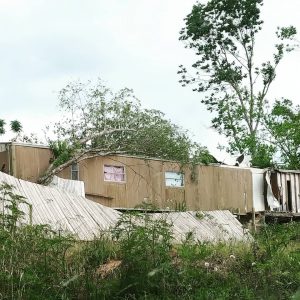
Being prepared for an emergency can greatly reduce the stress it causes. (Photo source: Stephanie Herzog)
There are also so many ways to prepare for emergencies that it can be overwhelming to think about. Do you have sufficient food storage? What about clean water for your whole family (pets included)? How are you going to wash your clothes? How do you purify water? What if your toilet isn’t usable, what do you do? Can you safely start a fire if there’s no heat? What about shelter? How do you stop a gaping wound? How do you turn off the water to your house? What is the best evacuation route? How do you contact someone when there’s no power? Are those potentially life-saving prescriptions easily accessible? Where is the deed to your house, the title to your car, and your family’s vital identification documents? You’re filing an insurance claim, and you have no idea what brand your Smart TV was, where you bought it, how old it was, or how much it cost – what do you do?
Preparation Brings Relief
Have all of these questions got you thinking, but perhaps exhausted you? Now imagine that you could answer every one of these questions confidently – how do you feel? A weight lifted? Stress is a central source of fatigue for us all, and with it comes a variety of problems – mental, physical, financial, and social. Think of a time when you were prepared for the expected or unexpected – was your stress considerably less? Most likely it was. Preparation is a positive, proactive behavior that gives foresight into the unknown. Procrastination tends to be the default within a human’s nature, so being prepared doesn’t necessarily sound like a fun thing to do with your time. But it will be a game-changer for your life when the time comes that you have to react swiftly and decisively in the event of an emergency. The investment is well worth it!
However, you don’t have to do it alone. Thankfully, there are many professionals here to help you! Here are a few starter tips to aid you in the beginning of your preparation:
- Human Life. First and foremost, in an emergency the highest priority is that of preserving human life. Material objects can be replaced – a life cannot be. Always keep this in mind while preparing for and responding to emergencies!
- Sustenance Storage. Have adequate food and water storage for your needs. Label your food and water storage with the month and year to help track expiration dates.
- Canned and dehydrated foods are great for storage, and many items have a long shelf life.
- Remember one gallon of water per person/pet per day – store as much fresh water as you can! You can only survive a few days without water, but weeks without food.
- Plan in your near future to eat and drink the food and water supply that are nearing expiration and then replace the storage with fresh sustenance.
- 72-Hour Kit. Have a 72-hour kit for each member of your family, including pets. Backpacks or duffel bags are ideal grab-and-go containers. Keep a 72-hour kit both in your home and in your car.
- Review Annually. Pick one Saturday a year as your “emergency preparedness day” where you review all of your food and water storage, medical supplies and prescriptions, fire extinguishers, and all other emergency materials.
- Make an inventory and then head to the store to replace any expired or missing items.
- Clean and organize your storage space and emergency kits so everything is accessible.
- Evacuation Plan. Have an evacuation plan and put it on the calendar to practice it with your family – and even neighbors – every three months.
Start now to be prepared!
Additional Resources
Sources
Jaffe, E. (2013, March.) Why wait? The science behind procrastination. Association for Psychological Science. https://www.psychologicalscience.org/observer/why-wait-the-science-behind-procrastination
Steel, P. (2007). The nature of procrastination: A meta-analytic and theoretical review of quintessential self-regulatory failure. Psychological Bulletin, 133(1), 65-94. http://dx.doi.org/10.1037/0033-2909.133.1.65








